Introduction
Myo-inositol is a chemical compound found in most life forms. It was discovered in muscle more than 150 years ago, but it is in the past 30 years that it has aroused strong interest from the scientific community because it has been recognized as a basic element of inositol 3-phosphate which acts as a second messenger in different cellular systems.
In recent years, an alteration of insulin signaling has been recognized as the main cause of the pathophysiology of polycystic ovary syndrome (PCOS). PCOS is the most common cause of infertility and affects more than 10% of women of reproductive age. Since the improvement of hyperinsulinemia and insulin resistance is among the main objectives in the management of the syndrome, new non-pharmacological approaches have been introduced.
The recent introduction of inositol in PCOS management has proven effective and safe in countering its effects.
In this article we will provide a detailed overview of myo-inositol, going to analyze what it is, what its benefits are, where it is found and in which foods and when it is important to integrate it.
What is Myo-inositol and where to find it
Inositol is a compound that belongs to the family of B vitamins and recently it has been discovered that it is also produced in large quantities in the body, starting from D-glucose.
99% of inositol in nature is present in the form of the myo-inositol (MYO) isomer, the remaining 1% is in the form of D-chiro-inositol (DCI).
MYO represents the structural basis of numerous second messengers, thus participating in various processes such as:
- the development and functioning of peripheral nerves;
- osteogenesis;
- reproduction and fertility;
- carbohydrate metabolism.
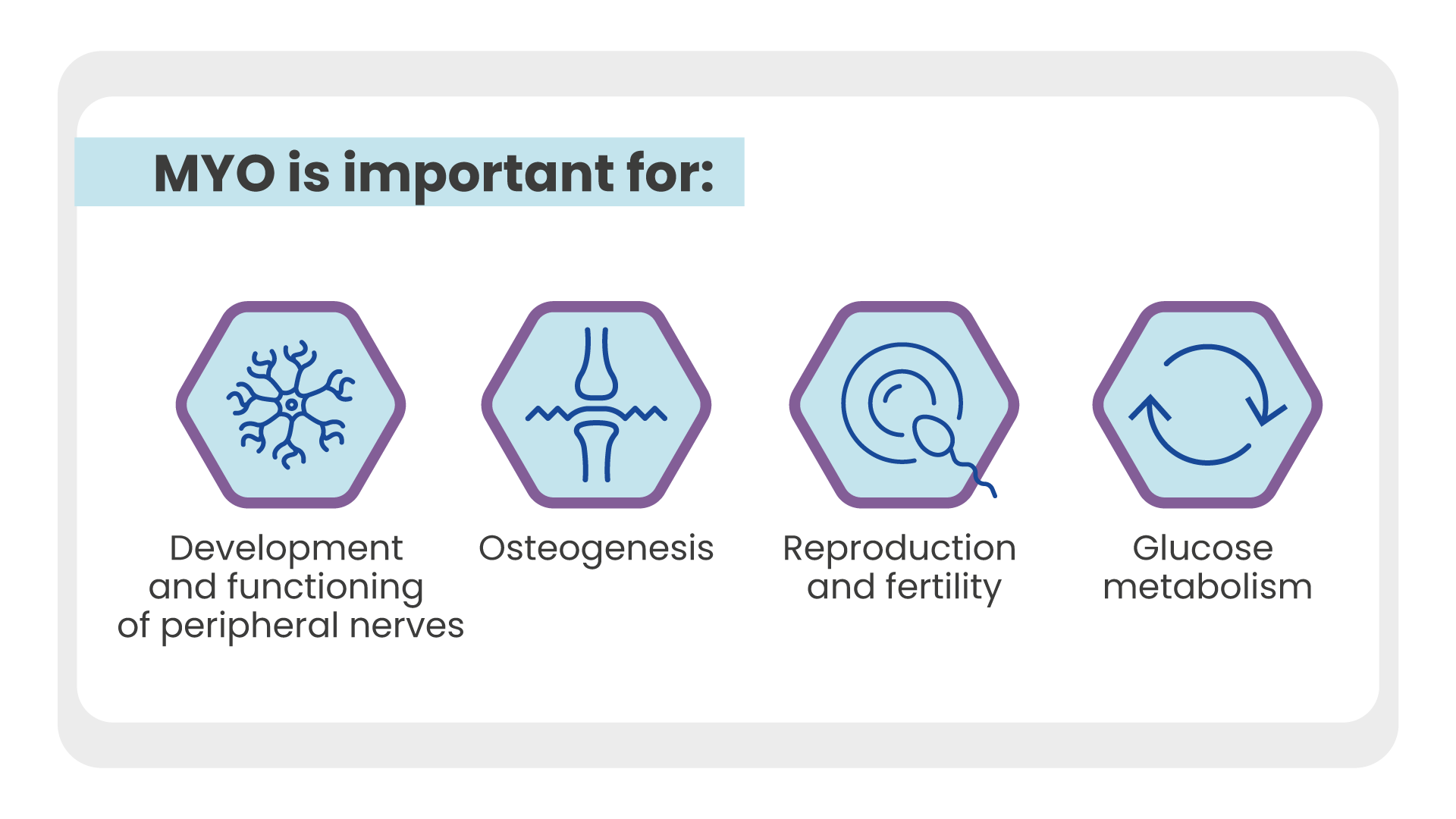
Animal tissues, especially the brain and muscles, are rich in it. High quantities of myo-inositol are present in the sperm, oocyte and embryo during the early stages of embryonic development.
MYO is also synthesized endogenously from glucose 6-phosphate, and is found at the level of cell membranes such as phosphatidylinositol phosphate, i.e. linked to membrane phospholipids. In addition, it is converted into D-chiro-inositol by an insulin-dependent epimerase [1].
This natural molecule is particularly important as it regulates the activity of different hormones:
- the hormone insulin;
- thyroid stimulating hormone (TSH);
- and follicle stimulating hormone (FSH).
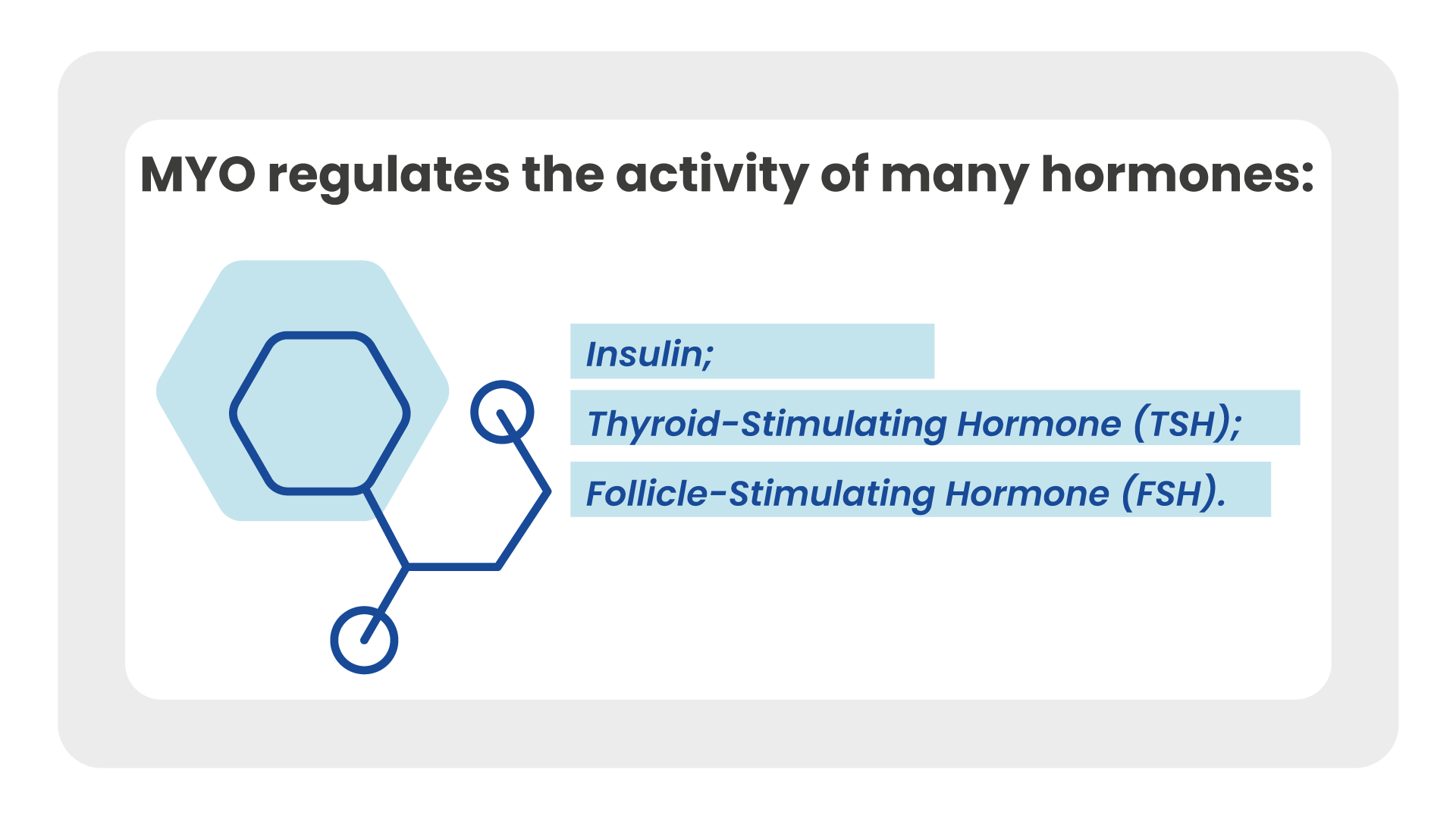
History of Myo Inositol
In 1850, Johann Joseph Scherer isolated from the muscle a hexahydroxy-cyclohexane which he called “Inositol” [from the ancient Greek ìs (in-, “sinew, fiber”), -ose (which indicates a carbohydrate), -ite (” ester “), -ol (” an alcohol “)] [2].
His discovery aroused the interest of numerous academics for inositol and its derivatives.
In 1887, after extracting the inositol from some leaves, Maquenne coined the definition of its structure in cyclohexanol [3]. Nine possible forms of stereoisomers can occur after the epimerization of the six OH- groups: cis-, epi, allo-, myo-, neo-, scyllo, L-chiro-, D-chiro- and muco- ins.
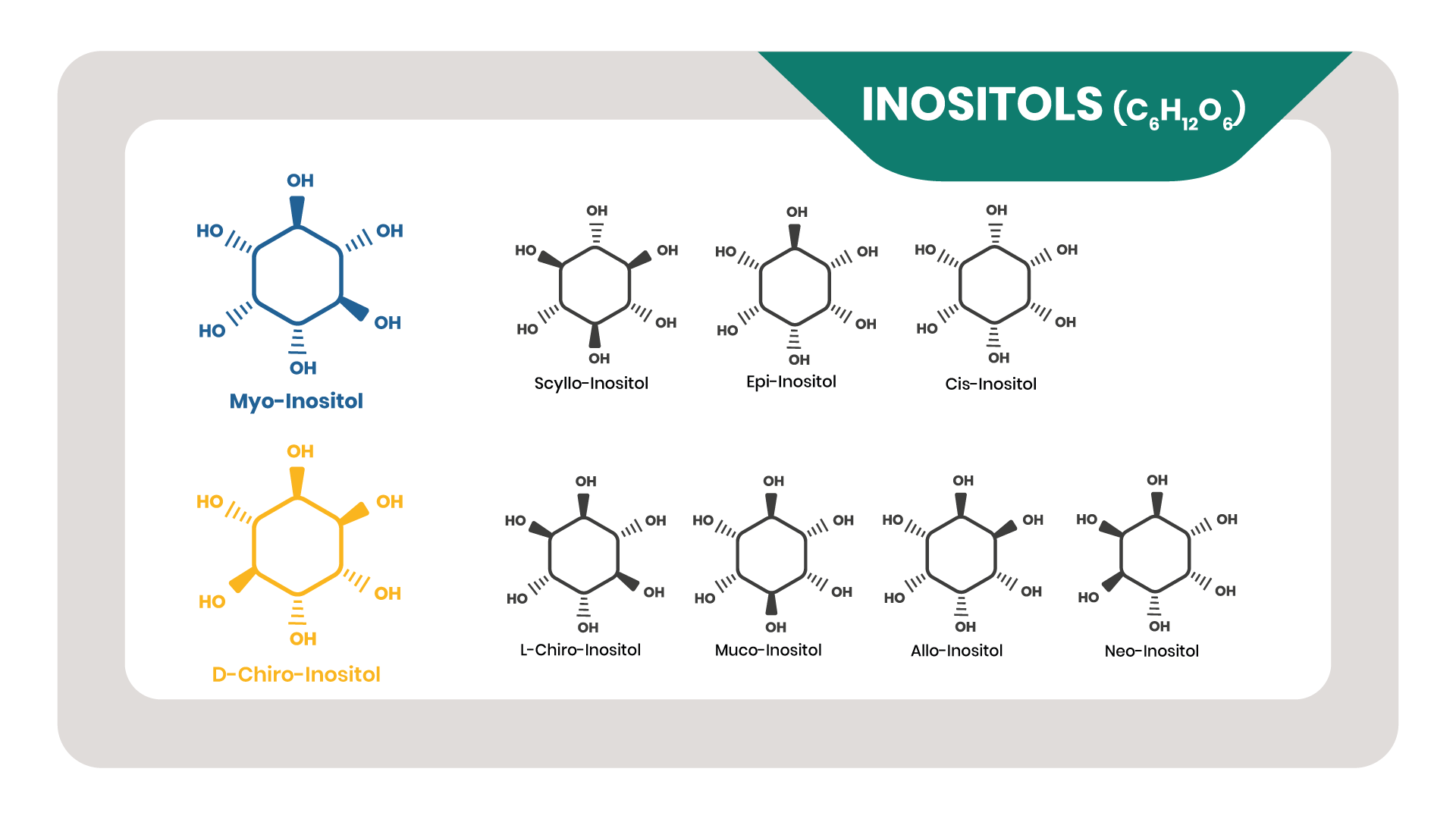
Over the years, researchers from all over the world have extended the investigation to search for MYO concentrations in different organs and tissues. Eisenberg and Bolden in 1964 discovered that the testicles were rich in MYO in free form [5]. Further studies have also shown the presence of high levels of this substance in the prostate, epididymis and seminal vesicles. Seminal fluid is one of the richest sources of inositol with an almost triple concentration compared to that found in plasma.
At the end of the 1980s, Larner studied the action of intracellular insulin mediators with the aim of identifying new potential active ingredients effective in the treatment of diabetic diseases.
Larner proposed, for the first time, the existence of multiple insulin mediators, suggesting that after the binding of insulin to its receptor, the second step could evolve in different paths, depending on the mediator stimulated.
In 1988, he concluded that MYO and DCI are chemical mediators of insulin and that act through different mechanisms of action by activating different intracellular pathways, in relation to the tissue involved [6].
To learn more read: D-chiro-inositol: what it is, use and benefits
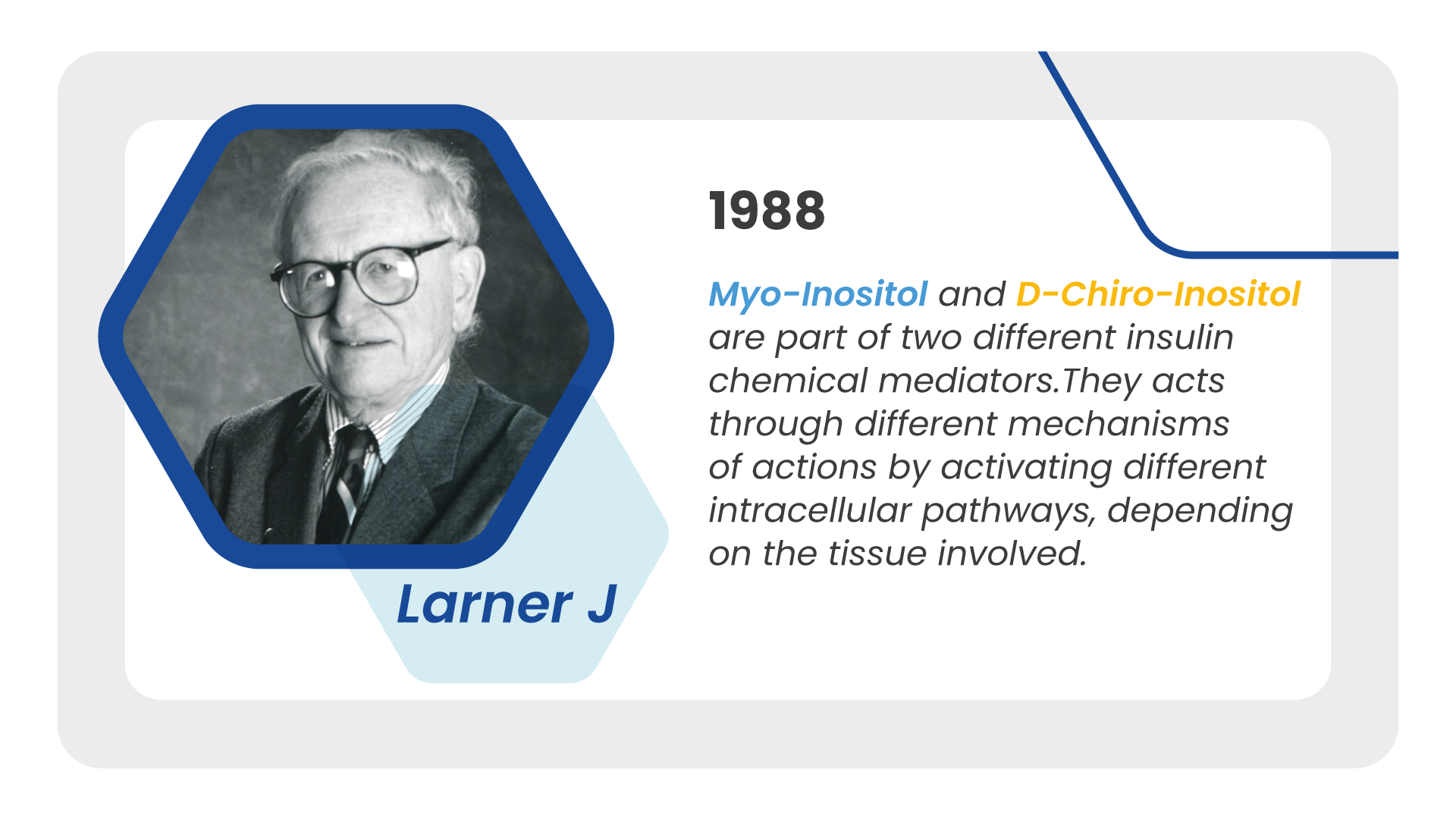
Difference between inositols: myo-inositol and d-chiro-inositol
When we talk about inositol we have to be careful, because we refer in general to a number of 9 molecules, the difference of which is given by the spatial arrangement of the chemical group -OH.
Myo-inositol is the most present in nature. Thanks to a specific enzyme, it is converted into another stereoisomer, D-chiro-inositol, less abundant and which plays a different role from myo-inositol within the human body. A peculiarity of these two inositols is their distribution in the tissues [7]. In fact, each tissue and / or organ maintains a specific relationship of these two molecules, fundamental for correct functionality.
Each tissue has a different MI: DCI ratio specific for the functions performed and the plasma ratio of MYO and DCI is 40:1.
To learn more read: The true story of MYO and D-Chiro 40:1
MYO constitutes 99% of the intracellular pool of inositols in the tissues, while the remainder is DCI. In particular, in the follicles high concentrations of MYO can support the correct maturation of the oocyte. Scientific studies have shown that, people with PCOS the ratio of Myo-inositol/D-chiro-inositol is altered compared to healthy subjects,instead. It is essential to re-establish and maintain this specific MYO:DCI relationship to optimally treat PCOS.
MI and DCI carry out various activities within the body: MI mainly promotes the absorption of glucose, while DCI promotes the synthesis of glycogen.
To learn more read: The difference between inositol, Myo-inositol and D-Chiro-inositol
Myo-inositol: properties and benefits
Myo-inositol is second messenger of FSH, the Follicle-Stimulating Hormone which helps control the menstrual cycle and stimulates the growth of eggs in the ovaries.
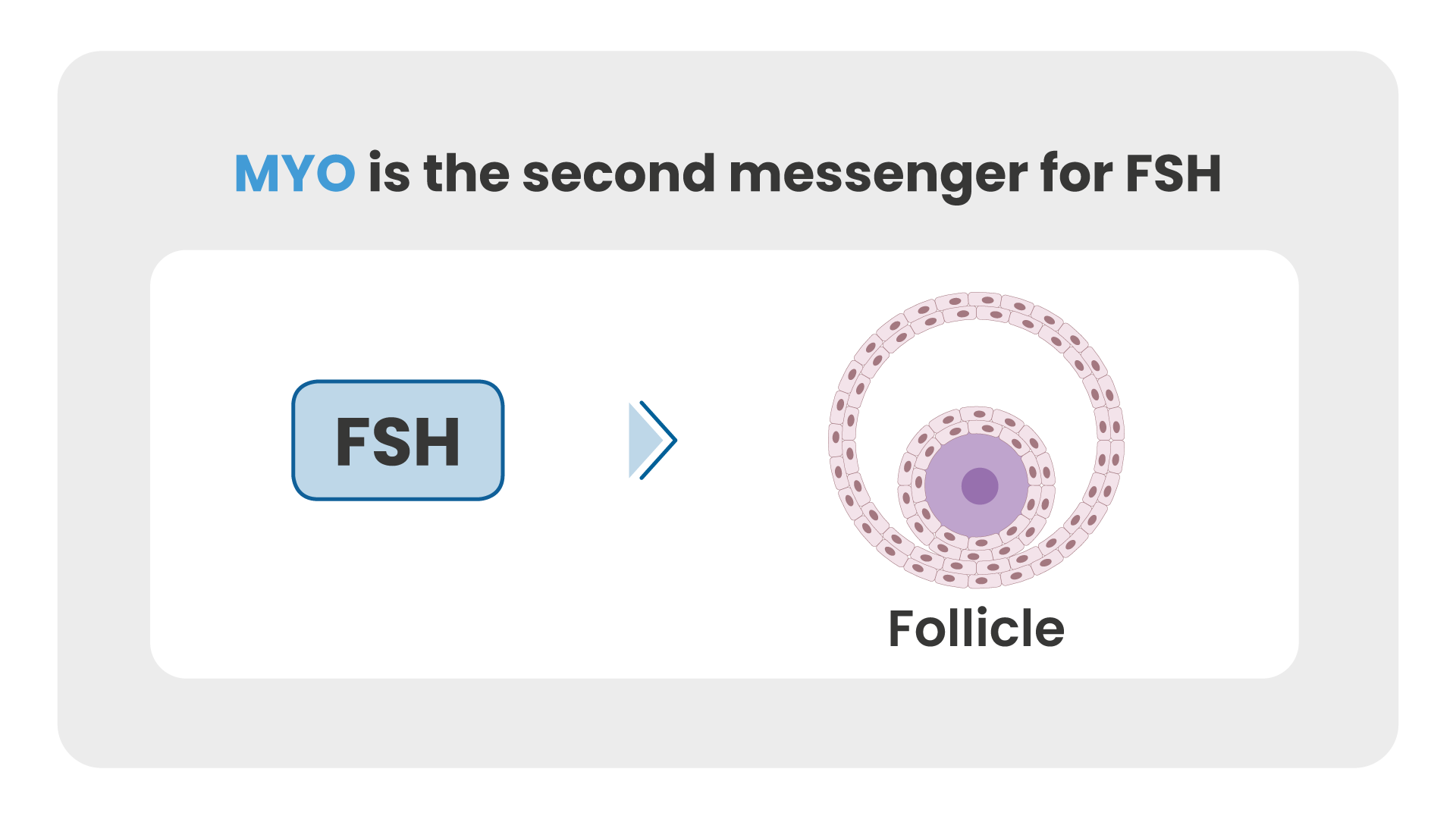
The ovarian reserve is defined as the number and quality of the oocytes present in the organism at a given time.
These two parameters are closely related: in women who have few residual oocytes, the same are also of poor quality. Numerous studies have shown how supplementation with MYO can promote the improvement of the oocyte quality through a molecular system of calcium displacement always active and functional for the correct growth of the oocytes.
MYO supplementation is also effective in improving glycemic tolerance and appears to have a promising role in preventing the onset of diabetes in pregnant women at high risk for the development of gestational diabetes [7].
There were several risk factors tested in some clinical studies (positive history, borderline hyperglycaemia in the first trimester, obesity) and which showed how MYO was able to prevent the onset of gestational diabetes in all cases.
An important meta-analysis assessed the protective effect of MYO which led to a significant reduction in the onset of gestational diabetes equal to 80%, compared to non-treatment [8].
The integration with myo-inositol becomes clinically relevant when the effectiveness is associated with the reduction of related morbidity, such as hypertension and the risk of developing type II diabetes over time.
To learn more visit the section dedicated to Inositols and Overweight
Examples of use of Myo-inositol
MYO supplementation has shown that it can prevent and improve insulin resistance in PCOS women and in postmenopausal women with metabolic syndrome [9].
Such an important physiological effect could not fail to impact with various clinical pathologies linked to dysmetabolism and therefore with the modern meaning of insulin resistance, a condition in which greater insulin secretion is required in order to maintain normal glucose levels.
Polycystic ovary syndrome (PCOS) is an endocrine and hormonal syndrome very common among women of reproductive age, often related to an insulin resistance (IR) condition, in which hyperinsulinemia and hyperandrogenism can be found. In fact, almost all obese women with PCOS and more than 50% with normal weight are insulin resistant, and have a moderate degree of hyperinsulinemia.
Administration for 6 months with MYO has been linked to an improvement in the physiological activity of the insulin receptors. The results showed that both treatments improve metabolic parameters and the restoration of ovulation in women with overweight PCOS. In particular, fasting insulin and glucose levels are significantly reduced at the end of treatment [10].
Daily supplementation for 12 months with 2g of MYO, twice a day, in postmenopausal women with metabolic syndrome showed a significant reduction in the HOMA-IR index (Evaluation of the homeostatic insulin resistance model) by -78% compared to the group placebo, under treatment with diet alone [11].
Interestingly, in this category of patients, cardiovascular risk parameters also improved further after supplementation with MYO, recording a decrease in blood pressure, LDL cholesterol, serum triglycerides (-34%) and an increase in HDL cholesterol ( -21%). At the end of the study, 8 out of 40 women (i.e. 20%) had no more metabolic syndrome than one patient (i.e. 2.5%) in the placebo group. In pregnant women with a family history of diabetes, MYO (administered at 4g / day during pregnancy) significantly improved glucose tolerance and reduced the incidence of gestational diabetes [12].
Based on this evidence, the main role of MYO in rapidly reducing peripheral hyperinsulinemia and improving ovulatory function is confirmed.
How to take Myo-inositol
Inositol is taken jointly with food, but the sufficient amount taken by healthy subjects is not enough for those who suffer from specific diseases.
In particular, in the case of PCOS, we can say today that inositol represents a key element to improve the metabolic and hormonal response.
For further information read: The benefits of myo-inositol for the polycystic ovary
Numerous studies have shown the effectiveness of this molecule with the intake of 2 g of MYO twice a day, for a total of 4 g, for the powder formulations, i.e. sachets and tablets. The soft capsule formulations allow a greater bioavailability of the active ingredient, so the dosages are reduced, equal to 600 mg. In addition to the importance of dosages, studies highlight two other key elements for the effectiveness of these two molecules. The first is the intake, for the powder formulations, away from meals in order not to interfere with their absorption. Secondly, administration should be repeated throughout the day. Kinetic studies have shown a 12-hour half-life of inositol.
By using double administration, better coverage of the insulin response is obtained [13].
Conclusions
The physiological role and benefits of Myo-inositol (MYO) are now widely documented and recognized: its action as a second messenger of important hormones such as insulin, FSH and TSH is of particular relevance [14].
In this sense, the contribution of scientific research in the diffusion of the properties and of the possible use of this extraordinary molecule in various specialized fields has been decisive:
- PCOS;
- gestational diabetes;
- metabolic syndrome;
Today we know that Myo-inositol supplementation represents an effective, valid and safe strategy.
Sources
[1] Heimark D, McAllister J, Larner J. Decreased myo-inositol to chiro-inositol (m/c) ratios and increased m/c epimerase activity in pcos theca cells demonstrate increased insulin sensitivity compared to controls. Endocr J 2014; 61: 111-7.
[2] Irvine, Robin F. 2016. “A short history of inositol lipids.” Journal of Lipid Research 57 (11):1987-1994. doi: 10.1194/jlr.R071712.
[3] Maquenne, Léon. 1887a. “Préparation, proprietés et constitution se l’inosite.” Comptes Rendus Hebdomadaires Des Seances De l’Academie Des Sciences 104:225-227.
[4] Agranoff, B. W. 2009. “Turtles All the Way: Reflections on myo-Inositol.” J Biol Chem 284 (32):21121-6. doi: 10.1074/jbc.X109.004747.
[5] Eisenberg, F., A. H. Bolden, and F. A. Loewus. 1964. “Inositol formation by cyclization of glucose chain in rat testis.” Biochem Biophys Res Commun 14:419-24.
[6] Larner J, Huang LC, Schwartz CF, Oswald AS, Shen TY, Kinter M, Tang GZ, Zeller K. Rat liver insulin mediator which stimulates pyruvate dehydrogenase phosphate contains galactosamine and D-chiroinositol. Biochem Biophys Res Commun 1988a;151(3): 1416-26.
[7] Larner, J. 2002. “D-chiro-inositol–its functional role in insulin action and its deficit in insulin resistance.” Int J Exp Diabetes Res 3 (1):47-60.
[8] Crawford, Tineke J., Caroline A. Crowther, J. Alsweiler, and J. Brown. 2015. Antenatal Dietary Supplementation with Myo-Inositol in Women during Pregnancy for Preventing Gestational Diabetes. The Cochrane Database of Systematic Reviews.
[9] Giordano, D., F. Corrado, A. Santamaria, S. Quattrone, B. Pintaudi, A. Di Benedetto, and R. D’Anna. 2011. Effects of Myo-Inositol Supplementation in Postmenopausal Women with Metabolic Syndrome: A Perspective, Randomized, Placebo-Controlled Study. Menopause (New York, N.Y.) 18 (1): 102‑4.
[9] Unfer, V., F. Facchinetti, B. Orru, B. Giordani, and J. Nestler. 2017. “Myo-inositol effects in women with PCOS: a meta-analysis of randomized controlled trials.” Endocr Connect 6 (8):647-658. doi: 10.1530/ec-17-0243.
[10] Santamaria, A., D. Giordano, F. Corrado, B. Pintaudi, M. L. Interdonato, G. Di Vieste, A. Di Benedetto, and R. D’Anna. 2012. One-Year Effects of Myo-Inositol Supplementation in Postmenopausal Women with Metabolic Syndrome. Climacteric: The Journal of the International Menopause Society 15 (5): 490‑95.
[11] DʼAnna, R., A. Di Benedetto, A. Scilipoti, A. Santamaria, M. L. Interdonato, E. Petrella, I. Neri, B. Pintaudi, F. Corrado, and F. Facchinetti. 2015. Myo-Inositol Supplementation for Prevention of Gestational Diabetes in Obese Pregnant Women: A Randomized Controlled Trial. Obstetrics and Gynecology 126 (2): 310‑15.
[12] Orrù B, Circo R, Logoteta P, Petousis S, Carlomagno G. 2017. Finding the best therapeutic approach for PCOS: the importance of inositol(s) bioavailability.
[13] Croze, M. L., and C. O. Soulage. 2013. Potential Role and Therapeutic Interests of Myo-Inositol in Metabolic Diseases. Biochimie 95 (10): 1811‑27
Other topics that may interest you
D-chiro-inositol
40:1
Alpha-lactalbumin
PCOS
Overweight